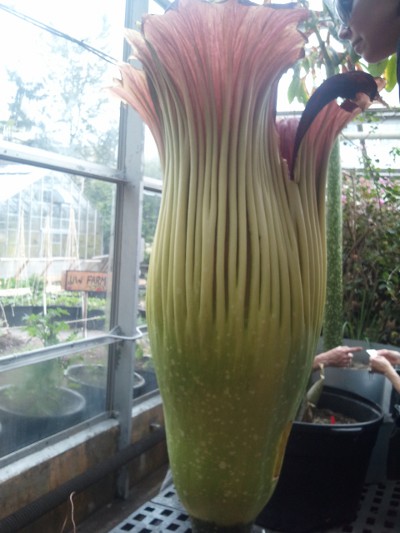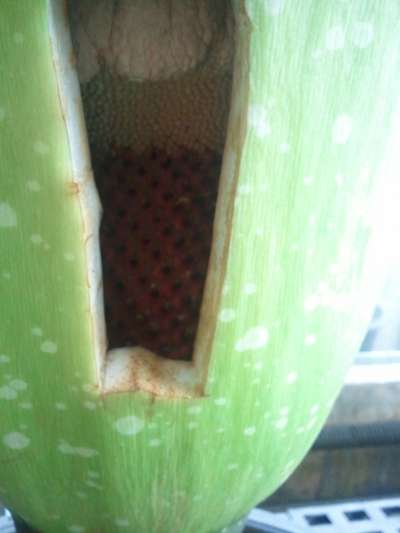Opinion

The Blooming of the Giant Corpse Flower:
Why Librarians Should Care.
By Karl Eckler
 Just in time for graduation, a UW hidden treasure has revealed itself. The tropical plant collection at the UW farm was full to bursting--the lines stretched out of the building and into the parking lot. Scores of parents of small children dutifully waited in that line (internally labeled by this reporter as "the dry line") and the other (moister) line that begins inside the glass door marked "Please close the door...maybe it will flower." The impatient queue wilts in Sumatran heat, making nervous conversation while shuffling past the delicious Theobroma cacao and the yellow spangled red towers of the Costus barbatus towards their grimly named and grimly suffered for destination: Amorphophallus1 titanum, The Giant Corpse Flower.
Just in time for graduation, a UW hidden treasure has revealed itself. The tropical plant collection at the UW farm was full to bursting--the lines stretched out of the building and into the parking lot. Scores of parents of small children dutifully waited in that line (internally labeled by this reporter as "the dry line") and the other (moister) line that begins inside the glass door marked "Please close the door...maybe it will flower." The impatient queue wilts in Sumatran heat, making nervous conversation while shuffling past the delicious Theobroma cacao and the yellow spangled red towers of the Costus barbatus towards their grimly named and grimly suffered for destination: Amorphophallus1 titanum, The Giant Corpse Flower.
 This plant is huge. The bloom has been measured up to 10 feet tall2 at the Winnipesaukee Orchids in Gilford, New Hampshire, but the perfume is positively putrid: The Indonesian name for the plant--bunga bangkai--means "corpse flower" and it lives up to the name, producing the charnel stench to attract flies, which in turn pollinate the hundreds of tiny flowers in the base of the blooming structure, or Inflorescence3.
This plant is huge. The bloom has been measured up to 10 feet tall2 at the Winnipesaukee Orchids in Gilford, New Hampshire, but the perfume is positively putrid: The Indonesian name for the plant--bunga bangkai--means "corpse flower" and it lives up to the name, producing the charnel stench to attract flies, which in turn pollinate the hundreds of tiny flowers in the base of the blooming structure, or Inflorescence3.
This bloom is so large that it’s found its way into the record books, and so rare that we swarm like flies to see it. The flowering occurs on an unpredictable schedule, happening as often as once a year and yet sometimes skipping as many as thirty years before disinterring itself. All told, a fairly distinctive and difficult to confuse plant, right?
Wrong.
You see, the term "corpse flower" also applies to a genus of plants known as Rafflesia. one of which (Rafflesia arnoldii), while smaller, is technically the world’s largest flower. A notable fact above and beyond it’s extraordinary nature: it lacks leaves, stems and even true roots, existing as a parasite on other, larger plants.
This confusion points out possibilities of overlap between the biological and informational sciences. As Stephen Hopper puts it, "every name is a hypothesis4," and he should know, being the 14th Director of Kew Botanic Gardens in London, a place with one or two Amorphophallii under their belts. This is because the nature of naming, the construction of controlled vocabularies in the natural sciences, was co-eval with the expansion of European Colonialism.
Different cultures put their stamp on the world in different ways, including how they named the plants that they "discovered." This is causing miscommunication among the community of international botany because, "an essential first step in any communication is to have reliable, accurate names [and] on average there are three or four names in the scientific literature for every plant species on the planet." Thus enters Information Science, a discipline that has a great deal of expertise in marrying together or translating from different catalog schemes.
The result of this is the deceptively simply named "Plant List" ("http://www.theplantlist.org/) a union catalog, if you will, for plants. The database, freely accessible on the web, contains over a million plant names, including the 298,000 odd accepted Latinate names.
"The power of it will be that we will have online reliable names for people to then enter into the world of information about plants," says Stephen Hopper.
Thanks Professor, I couldn't have said it better myself.
And If I tried, it would be something cheeky like: "Libraries, they’re getting to be really steamy places these days." The principles of Informatics have applications towards almost every branch of endeavor, something that is useful to remember when on the job hunt: A librarian can turn up in the strangest of places, from a freezing Air Force Base in Minot North Dakota to a sweltering jungle 10 minutes walk from Mary Gates Hall.
1 You’ll have to go to Wikipedia (http://en.wikipedia.org/wiki/Amorphophallus_titanum) to know what Amorphophallus means, because this is a family-friendly website, but there’s a reason for David Attenborough inventing yet another of the plant’s names, the Titan Arum. And that reason is that "Attenborough felt that constantly referring to the plant as "Amorphophallus" on a popular TV documentary would be inappropriate.
2 At the original pub-brawl preventor, The Guinness Book of World Records: http://www.guinnessworldrecords.com/Search/Details/Tallest-bloom/60324.htm
3 "a group or cluster of flowers arranged on a stem that is composed of a main branch or a complicated arrangement of branches." -- http://en.wikipedia.org/wiki/Inflorescence
4 All of Professor Hopper’s quotes are from his appearance on the BBC radio program, The Forum on 11/06/2011: http://www.bbc.co.uk/programmes/p00h35lg
